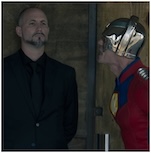Kill Switch

Watching Tim Smit’s Kill Switch is a lot like watching over your friend’s shoulder as he plays a first-person shooter. It’s exciting at first, when neither of you have more than a vague sense of what it’s about; then merely interesting, when the conceit is clarified and the shape of its plot coheres; and then tedious to the point of boring, because you desperately want to get in a round, but your buddy just won’t give up the controller. The tedium intensifies in the context of a movie, of course, because there’s no such thing as consumer control when watching movies. By their very nature, they’re indifferent. They tell the same story the same way each and every single time, whether played for a packed theater, or at home for a lone viewer.
First-person perspectives aren’t a new thing in the movies. Just go back to 2016 and see if your constitution is strong enough to tolerate Hardcore Henry, or maybe take a gander at the first-person sequence in 2005’s Doom. Kill Switch shares more in common with the latter than the former, being comprised of roughly half third-person sequences where Dan Stevens is required to emote hangdog mystification and sober regret, and half first-person POV shots where Stevens is heard, not seen, and by consequence disappears into the picture. There’s never a reason given for the film’s rotating vantage points; they just rotate, with the first-person sequences usually fading into third-person flashbacks following an explosive set piece that leaves Stevens’ character unconscious.
Maybe Smit meant to tell Kill Switch entirely through the first-person, but found that he couldn’t justify hiring an actor as dapper and good-looking as Stevens without showing his face, or maybe there’s subtext to the shift in aesthetic that isn’t immediately obvious. Most likely, Smit just thought using the first-person would enhance the film’s action, and the third-person would help maintain his themes and throughlines. Whatever his reasoning, his approach doesn’t quite work: It drives a wedge in Kill Switch’s pacing, first generating inertia, then dispersing it in a single fade to black before starting the process afresh. Imagine sitting passenger side in a car whose driver alternates pumping the brakes and flooring the gas, and you more or less have an idea of what it’s like to sit through Kill Switch.
-

-

-

-

-

-

-

-

-

-

-

-

-

-

-

-

-

-

-

-

-

-

-

-

-

-

-

-

-

-

-

-

-

-

-

-

-

-

-

-








































